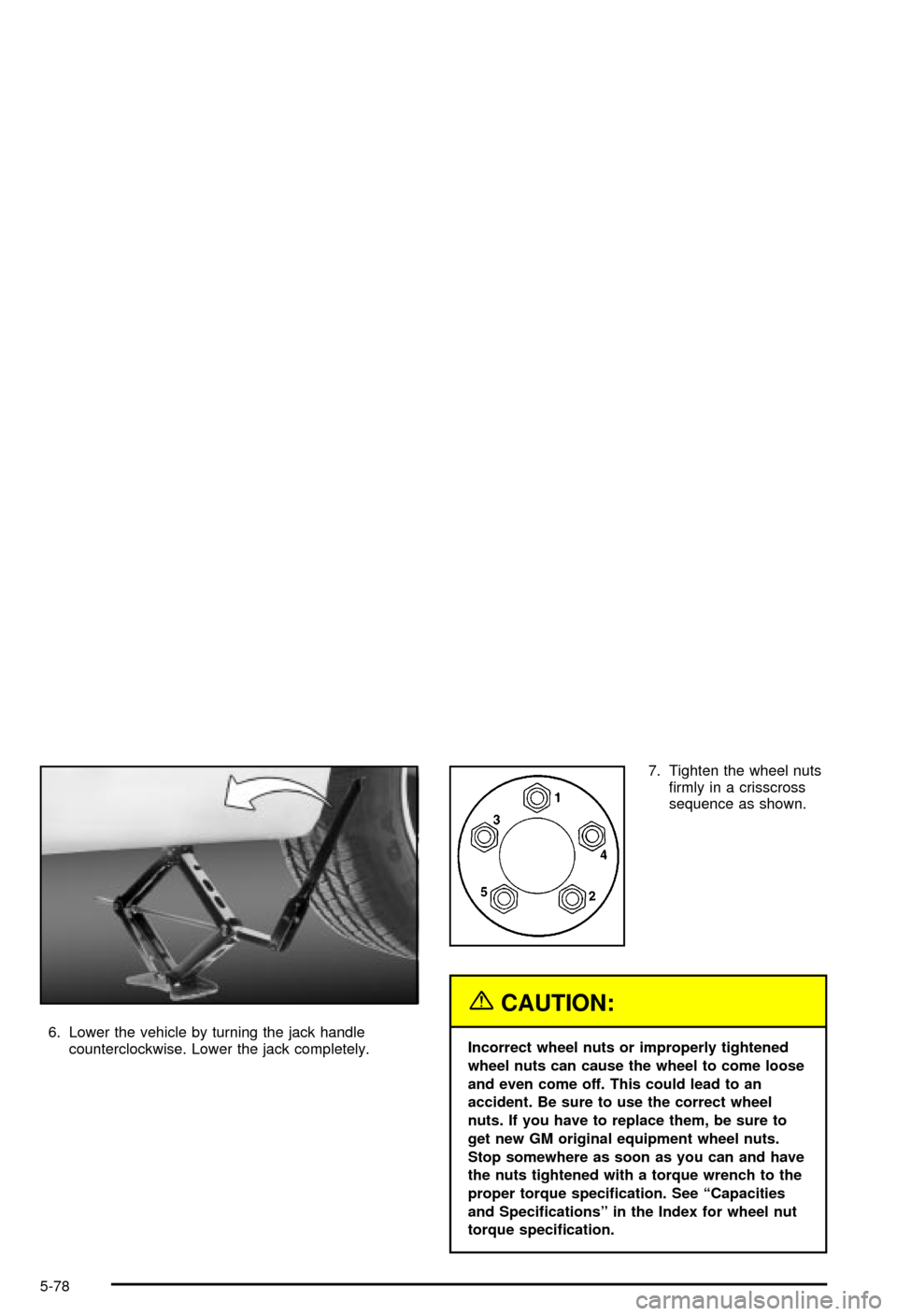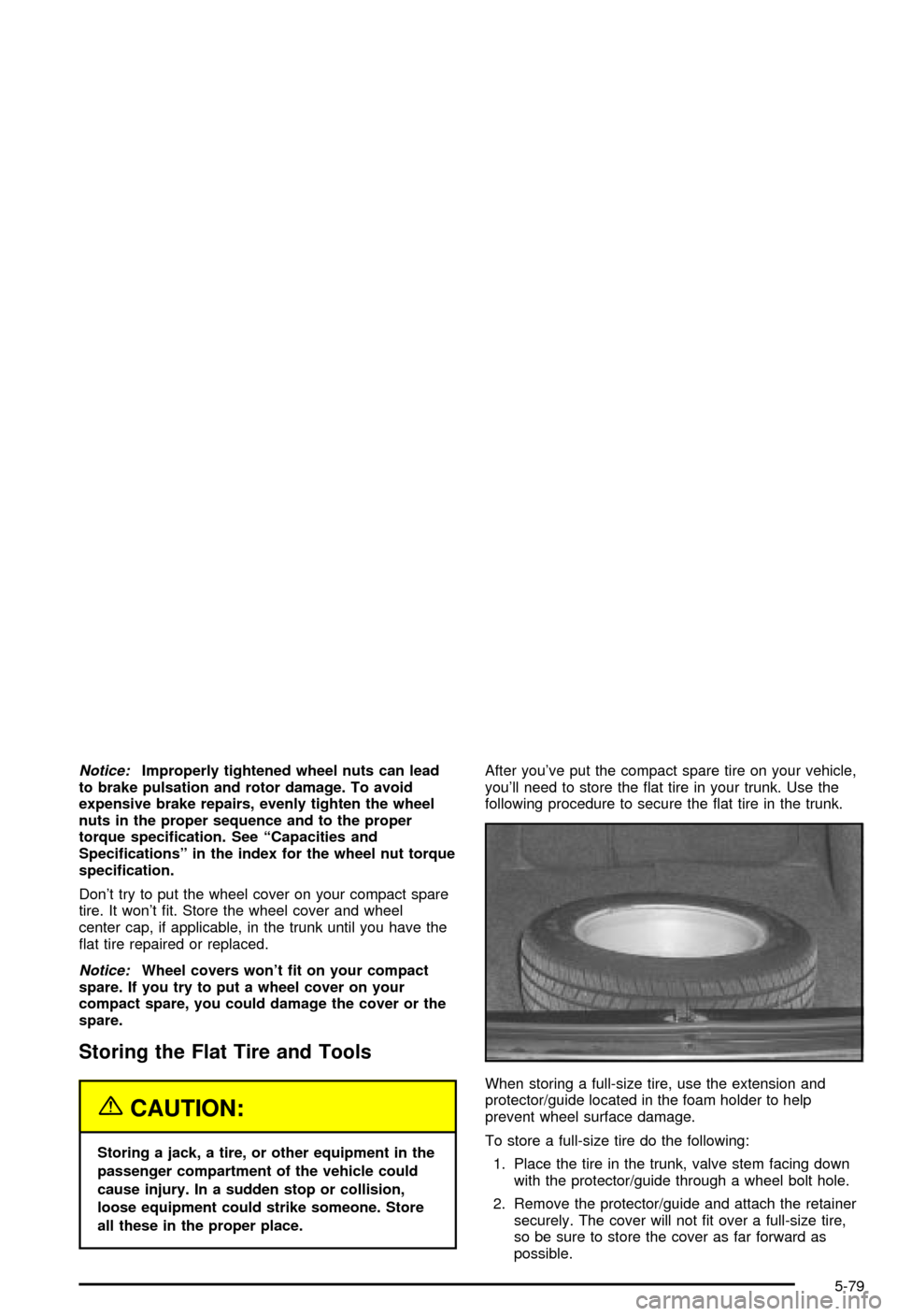2003 CHEVROLET MONTE CARLO wheel torque
[x] Cancel search: wheel torquePage 294 of 394

Brake Wear
Your vehicle has four-wheel disc brakes.
Disc brake pads have built-in wear indicators that make
a high-pitched warning sound when the brake pads
are worn and new pads are needed. The sound
may come and go or be heard all the time your vehicle
is moving (except when you are pushing on the
brake pedal ®rmly).
{CAUTION:
The brake wear warning sound means that
soon your brakes will not work well. That
could lead to an accident. When you hear the
brake wear warning sound, have your vehicle
serviced.
Notice:Continuing to drive with worn-out brake
pads could result in costly brake repair.
Some driving conditions or climates may cause a brake
squeal when the brakes are ®rst applied or lightly
applied. This does not mean something is wrong with
your brakes.
Properly torqued wheel nuts are necessary to help
prevent brake pulsation. When tires are rotated, inspect
brake pads for wear and evenly tighten wheel nuts in
the proper sequence to GM torque speci®cations.
Brake linings should always be replaced as complete
axle sets.
See
Brake System Inspection on page 6-15.
Brake Pedal Travel
See your dealer if the brake pedal does not return to
normal height, or if there is a rapid increase in
pedal travel. This could be a sign of brake trouble.
Brake Adjustment
Every time you apply the brakes, with or without the
vehicle moving, your brakes adjust for wear.
5-46
Page 311 of 394

Tire Inspection and Rotation
Tires should be rotated every 7,500 miles (12 500 km).
Any time you notice unusual wear, rotate your tires
as soon as possible and check wheel alignment. Also
check for damaged tires or wheels. See
When It Is Time
for New Tires on page 5-64andWheel Replacement
on page 5-67for more information.
The purpose of regular rotation is to achieve more
uniform wear for all tires on the vehicle. The ®rst rotation
is the most important. See ªPart A: Scheduled
Maintenance Services,º in Section 6, for scheduled
rotation intervals.
When rotating your tires, always use the correct rotation
pattern shown here.Don't include the compact spare tire in your tire rotation.
After the tires have been rotated, adjust the front and
rear in¯ation pressures as shown on the Tire-Loading
Information label.
Reset the Tire In¯ation Monitor System. See
Tire
Pressure Monitor System on page 5-61.
Make certain that all wheel nuts are properly tightened.
See ªWheel Nut Torqueº under
Capacities and
Speci®cations on page 5-98.
{CAUTION:
Rust or dirt on a wheel, or on the parts to
which it is fastened, can make wheel nuts
become loose after a time. The wheel could
come off and cause an accident. When you
change a wheel, remove any rust or dirt from
places where the wheel attaches to the vehicle.
In an emergency, you can use a cloth or a
paper towel to do this; but be sure to use a
scraper or wire brush later, if you need to, to
get all the rust or dirt off. See ªChanging a Flat
Tireº in the Index.
5-63
Page 326 of 394

6. Lower the vehicle by turning the jack handle
counterclockwise. Lower the jack completely.7. Tighten the wheel nuts
®rmly in a crisscross
sequence as shown.
{CAUTION:
Incorrect wheel nuts or improperly tightened
wheel nuts can cause the wheel to come loose
and even come off. This could lead to an
accident. Be sure to use the correct wheel
nuts. If you have to replace them, be sure to
get new GM original equipment wheel nuts.
Stop somewhere as soon as you can and have
the nuts tightened with a torque wrench to the
proper torque speci®cation. See ªCapacities
and Speci®cationsº in the Index for wheel nut
torque speci®cation.
5-78
Page 327 of 394

Notice:Improperly tightened wheel nuts can lead
to brake pulsation and rotor damage. To avoid
expensive brake repairs, evenly tighten the wheel
nuts in the proper sequence and to the proper
torque speci®cation. See ªCapacities and
Speci®cationsº in the index for the wheel nut torque
speci®cation.
Don't try to put the wheel cover on your compact spare
tire. It won't ®t. Store the wheel cover and wheel
center cap, if applicable, in the trunk until you have the
¯at tire repaired or replaced.
Notice:Wheel covers won't ®t on your compact
spare. If you try to put a wheel cover on your
compact spare, you could damage the cover or the
spare.
Storing the Flat Tire and Tools
{CAUTION:
Storing a jack, a tire, or other equipment in the
passenger compartment of the vehicle could
cause injury. In a sudden stop or collision,
loose equipment could strike someone. Store
all these in the proper place.After you've put the compact spare tire on your vehicle,
you'll need to store the ¯at tire in your trunk. Use the
following procedure to secure the ¯at tire in the trunk.
When storing a full-size tire, use the extension and
protector/guide located in the foam holder to help
prevent wheel surface damage.
To store a full-size tire do the following:
1. Place the tire in the trunk, valve stem facing down
with the protector/guide through a wheel bolt hole.
2. Remove the protector/guide and attach the retainer
securely. The cover will not ®t over a full-size tire,
so be sure to store the cover as far forward as
possible.
5-79
Page 347 of 394

Engine Speci®cations
Engine VIN Code Transmission Spark Pug Gap Firing OrderWheel Nut
Torque
3400 (LA1) V6 E 4T65E0.060 inches
(1.52 mm)1±2±3±4±5±6100 lb ft
140Y
3800 (L36) V6 K 4T65E0.060 inches
(1.52 mm)1±6±5±4±3±2100 lb ft
140Y
5-99
Page 392 of 394

Starting Your Engine.......................................2-18
Steering in Emergencies..................................4-11
Steering, Suspension and Front Drive Axle Boot
and Seal Inspection.....................................6-14
Steering Tips..................................................4-10
Steering Wheel Controls, Audio.........................3-90
Steering........................................................4-10
Storage Areas................................................2-39
Center Console Storage Area........................2-39
Convenience Net.........................................2-40
Glove Box..................................................2-39
Rear Storage Area.......................................2-39
Storing the Flat Tire and Tools..........................5-79
Storing the Spare Tire and Tools.......................5-80
Stuck in Sand, Mud, Ice or Snow......................4-28
Sun Visors.....................................................2-14
Sunroof.........................................................2-40
T
Tachometer....................................................3-33
Taillamps.......................................................5-56
Turn Signal, Stoplamps and
Sidemarker Lamps...................................5-56
TCS Warning Light..........................................3-37
Theft-Deterrent, Radio.....................................3-89
Theft-Deterrent Systems...................................2-14
Content Theft-Deterrent................................2-14
Passlock
ž...................................................2-16Throttle System Inspection...............................6-15
Tilt Wheel........................................................ 3-7
Tire In¯ation Check.........................................6-10
TIRE MON (Tire In¯ation Monitor Reset)............2-43
Tire ...............................................................3-48
Low Message.............................................3-48
Tires.............................................................5-59
Buying New Tires........................................5-65
Chains.......................................................5-69
Changing a Flat Tire....................................5-70
Compact Spare Tire.....................................5-81
If a Tire Goes Flat.......................................5-69
In¯ation -- Tire Pressure...............................5-60
Inspection and Rotation................................5-63
Pressure Monitor System..............................5-61
Uniform Tire Quality Grading.........................5-66
Wheel Alignment and Tire Balance.................5-67
Wheel Replacement.....................................5-67
When It Is Time for New Tires......................5-64
To Use the Engine Coolant Heater....................2-20
Top Strap Anchor Location...............................1-40
Top Strap......................................................1-39
Torque Lock...................................................2-26
Total Weight on Your Vehicle's Tires..................4-36
Towing..........................................................4-30
Recreational Vehicle.....................................4-30
Towing a Trailer..........................................4-34
Your Vehicle...............................................4-29
14